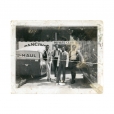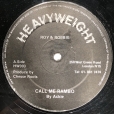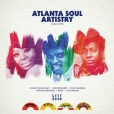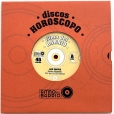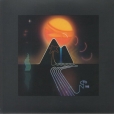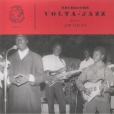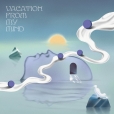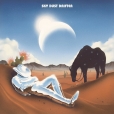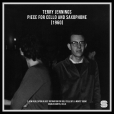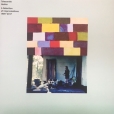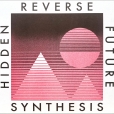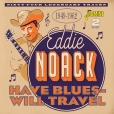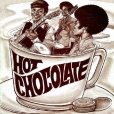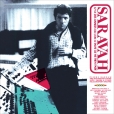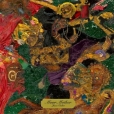Your basket is empty

Startlingly hot, raw, late-sixties funk and soul scorchers by this Arkansas band, named after the Stevie Wonder song, but evidently inspired by James Brown. Mostly out here for the first time, so this is terrific work by AOTN, who says it’s maybe the best LP they’ve released so far.
Warmly recommended.
The out-of-this-world recordings of Dilson de Souza, leading a kind of tropical chamber jazz on leaves from a ficus tree.
Dilson was from Barra do Pirai, in the Brazilian countryside; moving to Rio as a young man, where he worked in construction. He recorded his first record in 1954, for RCA Victor. He travelled to Quito around 1957, soon hooking up with Benitez & Valencia, who introduced him to the CAIFE label.
Dilson played the leaf open, resting on his tongue, hands free, with his mouth as the resonator. Though a leaf can also be played rolled or folded in half, this method allowed for more precision, a tethered brilliance. A picked ficus leaf stays fresh, crisp and clean-toned for around ten hours. He could play eight compositions, four at each end, before it was spent.
Biluka plays trills and vibratos effortlessly, with utterly pure pitch, acrobatically sliding into notes and changing tone on the fly. In Manuco, he leads Los Caníbales into a mysterious landscape on a rope pulled from an Andean spaghetti western, and corrals and teases them into a dialogue. A leaf, a harp, a xylophone, and a rondador — joined in Bailando Me Despido (Dancing As I Say Goodbye) by a saucy organ, doing sloshed call-and-response. In Anacu de Mi Guambra, Biluka shows his full range of antics, hiccuping melodically over a set of magic tricks. His expressiveness was boundless.
The eucalyptus leaf is popular among Aboriginal Australians. In China, they’ve played leaves for 10,000 years. In Cambodia, people play the slek, a leaf plucked from either the sakrom or the khnoung tree. But ain’t nobody like Biluka, ever.
Astounding music.
A moody, dubwise, to-the-barricades brew of jungle, rave, dubstep, and techno.
Over the five cuts, an opening, evocative, littoral play between discombobulation and mysticism gives way to mounting abrasiveness, before fetching up in the inner chambers of the temple room, echoing and spooky, with acoustic percussion.
Magnificent Wolof drum music, performed by an extended griot family in the mystical setting of Lac Rose, outside Dakar.
Doudou Ndiaye Rose — who died in 2015 — is a key drummer in the musical history of the world. He developed a system of five hundred original drumming patterns, ancient and new. Amongst the modern rhythms here is Bench Mi — ‘under the Baobab tree,’ a spot where where problems get solved. Also Hibar Yi — ‘passing on information’ — the theme-tune of Senegalese TV national news for decades — and Les Rosettes, the signature rhythm of Senegal’s first ever all-female percussion group, convened by Doudou, and named after his grandmother.
These original compositions sit alongside important traditional rhythms, familiar to every Sabar player, such as Farwu Jar ( a courtship game sometimes resulting in a wedding), Ceebu Jin (also the name of the national dish of fish and rice), and Gumbé, often played after a successful harvest.
Recorded in joyful single takes, over seven consecutive days in February 2020, with no overdubs, mastered by Rashad Becker, the music is deep and thrilling, polyrhythmic to the bone, with a complex, pointillistic intensity at times evoking Jeff Mills in full flight.
A groundbreaking, 1978 blend of Arab, jazz, Baroque pop, folk, and Brazilian styles like Bossa Nova, Tropicalia and MPB, with Fairouz’ son Ziad Rahbani as musical arranger, setting Palestinian poetry by Samih Al Qasem, Tawfiq Ziad, and the great Mahmoud Darwish.
Improvisatory, personal recordings made on various synthesisers between 1989 and 2017.
‘Amazing music that moves between abstract electronic experiments to melodic, DMT bent sounding, classical contemporary music and futuristic soundtracks from non-existing sci-fi movies you’ll wish you could see. It time-warps you from here to there then freezes the moment… very focused, unpretentious and highly emotive music . A wonderful and dreamy sound garden’ (Tako Reyenga, Music From Memory).
‘Chateauroux is mighty… A proper zoner. Flung on earth’ (John T. Gast).
A lovingly presented, outer-disciplinary collaboration featuring Ben Lancaster playing Moog, Sean Roche on saxophones, and visual artist Justin Hibbs. The music is a no-nonsense jazz stomper with Sun Ra running through its veins, and an eastern flavour; in two quite different arrangements.
Wonderful, hard-core country, with plenty of fiddles, honky-tonk piano, steel guitar, sexual neurosis, and razor-sharp wit, from one of the all-time greats.
Have Blues, Will Travel compiles singles releases between 1949 and 1962, across seven different record labels: Gold Star, 4-Star, TNT, Starday, “D”, Mercury and Allstar.
Take It Away Lucky… The Worm Has Turned…
‘Get hit by truck and get a busted head / Everybody says, Lucky, he ain’t dead. / Lucky old Ed, luckiest man in town.’
